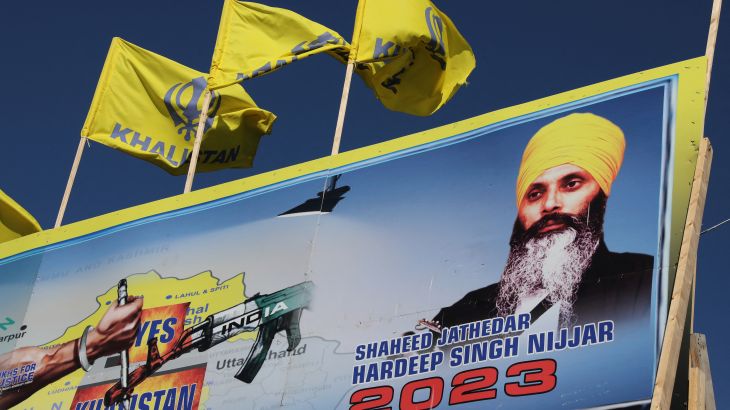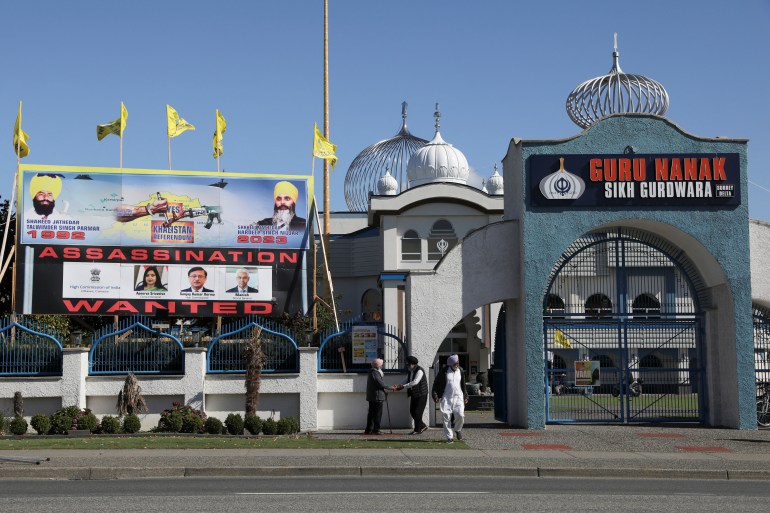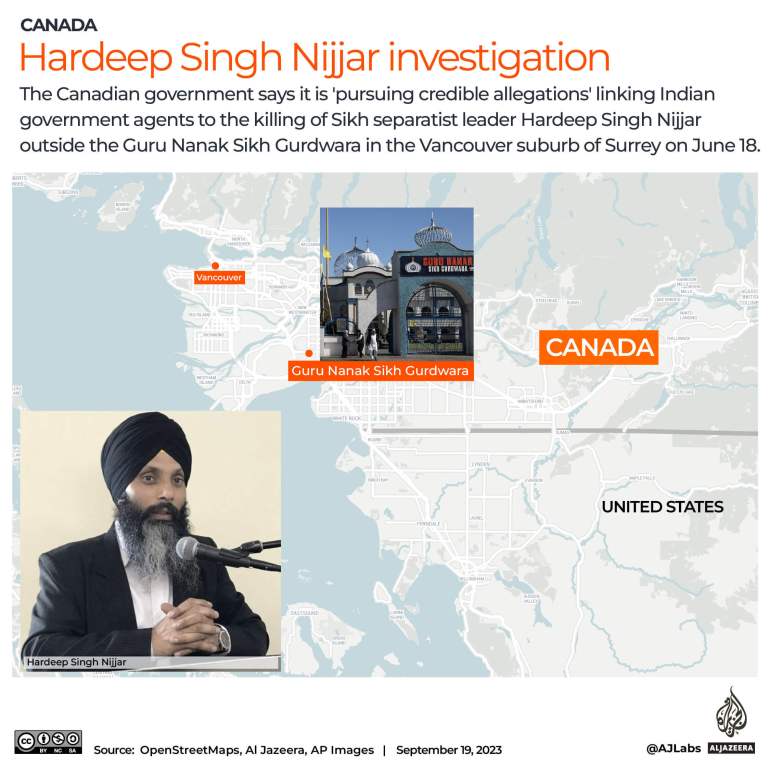Who was Hardeep Singh Nijjar whose killing triggered India-Canada tensions?
Ottawa and New Delhi expel diplomats as tensions escalate over the killing of Sikh separatist leader Hardeep Singh Nijjar.

In a tit-for-tat move, India has expelled a senior Canadian diplomat, hours after Ottawa expelled a top Indian official as tensions escalate between the two countries over the killing of Sikh separatist leader Hardeep Singh Nijjar earlier this year.
On Monday, Canadian Prime Minister Justin Trudeau described in parliament what he called credible allegations that India was connected to Nijjar’s assassination in British Columbia state in June.
Keep reading
list of 4 itemsCanada investigating possible link between India, killing of Sikh activist
Canada hits pause on trade mission to India after tensions at G20 summit
Sikh separatist Amritpal Singh arrested in India after manhunt
The Indian government dismissed the allegations as “absurd” and asked Canada instead to crack down on anti-India groups operating in its territory.
The row centres around the Sikh independence movement, commonly known as the Khalistan movement. India accuses Canada of sheltering Khalistani activists.
Here’s all you need to know:
What triggered the tensions?
Nijjar, 45, was shot dead outside a Sikh temple on June 18 in Surrey, a Vancouver suburb with a large Sikh population, three years after India had designated him as a “terrorist”.
Nijjar supported the demand for a Sikh homeland in India’s northern state of Punjab, the birthplace of the Sikh religion, which borders Pakistan. He was reportedly organising an unofficial referendum in India for an independent Sikh nation at the time of this death.
Trudeau on Monday said any involvement of a foreign government in the killing of a Canadian citizen was “an unacceptable violation of our sovereignty”.
On Tuesday, India’s Ministry of External Affairs (MEA) said allegations of India’s involvement in any act of violence in Canada are “absurd and motivated”.
It said the “unsubstantiated allegations” sought to shift focus away from “Khalistani terrorists and extremists who have been provided shelter in Canada”.
Indian authorities announced a cash reward last year for information leading to Nijjar’s arrest, accusing him of involvement in an alleged attack on a Hindu priest in India.

Trudeau said he brought up Nijjar’s killing with Prime Minister Narendra Modi at the Group of 20 (G20) Summit in New Delhi last week. He said he told Modi that any Indian government involvement would be unacceptable and that he asked for cooperation in the investigation.
“In the strongest possible terms, I continue to urge the government of India to cooperate with Canada to get to the bottom of this matter,” he said.
How did India respond?
The MEA dismissed the accusation that India was linked to Nijjar’s killing.
“Such unsubstantiated allegations seek to shift the focus from Khalistani terrorists and extremists, who have been provided shelter in Canada and continue to threaten India’s sovereignty and territorial integrity,” a ministry statement said.
India rejects allegations by Canada:https://t.co/KDzCczWNN2 pic.twitter.com/VSDxbefWLw
— Arindam Bagchi (@MEAIndia) September 19, 2023
On Tuesday, the foreign ministry said it had given a senior Canadian diplomat five days to leave the country, without disclosing his name or rank.
“The decision reflects the government of India’s growing concern at the interference of Canadian diplomats in our internal matters and their involvement in anti-India activities,” it said.
The ministry had summoned Cameron MacKay, Canada’s high commissioner in New Delhi, to notify him of the move, it added.
Earlier, New Delhi urged Ottawa to take action against anti-Indian groups in Canada.
“Allegations of the government of India’s involvement in any act of violence in Canada are absurd and motivated,” it said, adding that similar accusations made by Trudeau to Modi had been “completely rejected”.
Who was Hardeep Singh Nijjar?
Here is what is known about Hardeep Singh Nijjar, the man at the centre of the India-Canada row.
Nijjar was born in 1977 in Jalandhar district in India’s northern state of Punjab and moved to Canada in 1997, where he worked as a plumber, according to the Khalistan Extremism Monitor of the New Delhi-based independent Institute for Conflict Management.
He was initially associated with the Babbar Khalsa International (BKI) Sikh separatist group, according to India’s counter-terrorist, National Investigation Agency. New Delhi has listed BKI as a “terrorist organisation” and says it is funded by Pakistan’s Inter-Services Intelligence (ISI) spy agency, a charge Islamabad denies.

Nijjar later became chief of the Khalistan Tiger Force (KTF) group and was “actively involved in operationalising, networking, training and financing” its members, according to a 2020 Indian government statement.
New Delhi officially categorised him as a “terrorist” in the same statement, saying he was involved in “exhorting seditionary and insurrectionary imputations” and “attempting to create disharmony among different communities” in the country.
For supporters demanding a so-called independent Sikh state of Khalistan, Nijjar was a prominent leader and a strong voice for the cause.
He was elected head of the Guru Nanak Sikh Gurudwara, a Sikh place of worship, in Surrey, the Vancouver suburb where he lived. He held that position at the time of his death.
Nijjar was shot dead outside the same gurudwara on the evening of June 18.
Hundreds of people protested outside the Indian consulate in Vancouver after his murder, alleging foreign hands were involved in his death, local media reported at the time.
What is the Sikh separatist movement?
Sikhism is a minority religion originating in northern India that traces its roots back to the 15th century and drew influences from both Hinduism and Islam.
Its adherents make up less than two percent of India’s 1.4 billion people but Sikhs are nearly 60 percent of the population in the northern state of Punjab, the faith’s heartland.
India won its independence in 1947 but immediately suffered through the blood-soaked Partition that divided the former British colony along religious lines.
Muslims fled to the newly formed nation of Pakistan while Hindus and Sikhs fled to India in the ensuing violence, which killed at least one million people.
The historical region of Punjab was split between the two countries and was wracked by some of the worst violence of Partition.
Since then, some Sikhs have called for the creation of “Khalistan”, a separate sovereign nation and “land of the pure” carved out of Punjab and governed by the faith’s precepts.
Those calls grew louder in subsequent decades as Punjab became one of the wealthiest states in India, owing to an agricultural revolution that dramatically lifted farm yields.
The separatist movement began as an armed rebellion in the late 1980s among Sikhs demanding a separate homeland. The violent movement lasted more than a decade and was suppressed by an Indian government crackdown in which thousands of people were killed, including prominent Sikh leaders.
Hundreds of Sikh youths were also killed in police operations, many of which were later proven in courts to have been staged, according to rights groups.
In 1984, Indian forces stormed the Golden Temple, Sikhism’s holiest shrine, in Amritsar to flush out separatists who had taken refuge there. The operation killed about 400 people, according to official figures, but Sikh groups say thousands were killed.
The dead included Jarnail Singh Bhindranwale, whom the Indian government accused of leading the armed rebellion.
On October 31, 1984, then-Prime Minister Indira Gandhi, who had ordered the raid on the temple, was assassinated by two of her Sikh bodyguards.
Her death triggered a series of anti-Sikh riots, in which Hindu mobs went from house to house across northern India, particularly New Delhi, pulling Sikhs from their homes, hacking many to death and burning others alive.
BREAKING: Trudeau's statement regarding allegations of India's involvement in killing of Sikh leader in Canada pic.twitter.com/ECmwQqnkNY
— The Spectator Index (@spectatorindex) September 18, 2023
Canadian-based Sikh extremists were also accused of carrying out the 1985 bombing of an Air India flight, killing 329 people, for the Khalistan cause.
Is the movement still active?
There is no active rebellion in Punjab today, but the Khalistan movement still has some supporters in the state, as well as in the sizable Sikh diaspora overseas.
The Indian government has warned repeatedly over the years that Sikh separatists were trying to make a comeback. Modi’s government has also intensified the pursuit of Sikh separatists and arrested dozens of leaders from various outfits allegedly linked to the movement.
But Hartosh Bal, executive editor of The Caravan magazine in India, told Al Jazeera the Sikh separatist movement has been non-existent for decades.
“The Khalistan movement has a long history and during the 1980s, there was a violent military movement on Indian soil. But ever since – at least in India, in the state of Punjab, where the Sikhs are the majority – the Khalistan movement has been virtually non-existent, enjoys no political support and goes up and down depending on the attention the Indian government pays to it,” Bal said.
“This attention has gone up considerably since the Modi government came to power in 2014. It does have strong roots both in Canada and the UK, where things like referendums are held, but given that the vast majority of Sikhs are on Indian soil and are not participants in this referendum, these could have ideally been easily ignored.
“But the Modi government has consistently hyped up the Khalistani threat to India. I think, again, because it suits them domestically to talk about security threats to the Indian nation, rather than the actual measure of threat on the ground from the movement.”
How strong is the movement outside India?
India has been asking countries such as Canada, Australia and the United Kingdom to take legal action against Sikh activists. It has particularly raised these concerns with Canada, where Sikhs make up nearly 2 percent of the country’s population.
Earlier this year, Sikh protesters pulled down the Indian flag at the country’s high commission in London and smashed the building’s window in a show of anger against the move to arrest Amritpal Singh, a 30-year-old separatist leader who had revived calls for Khalistan and stirred fears of violence in Punjab.
Protesters also smashed windows at the Indian consulate in San Francisco and skirmished with embassy workers.
The MEA denounced the incidents and summoned the UK’s deputy high commissioner in New Delhi to lodge a protest against what it called the breach of security at the embassy in London.
The Indian government also accused Khalistan supporters in Canada of vandalising Hindu temples with “anti-India” graffiti and of attacking the offices of the Indian High Commission in Ottawa during a protest in March.
Last year, Paramjit Singh Panjwar, a Sikh separatist leader and head of the Khalistan Commando Force, was shot dead in Pakistan.